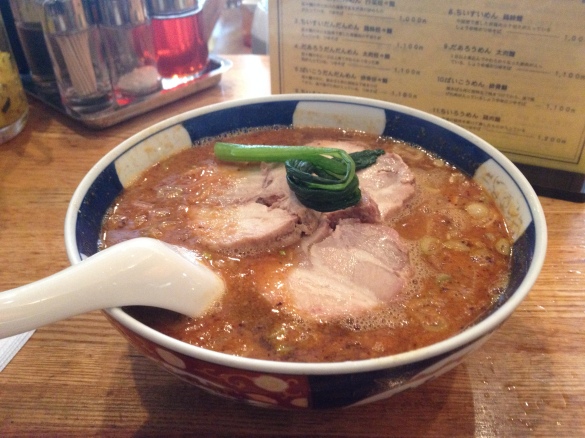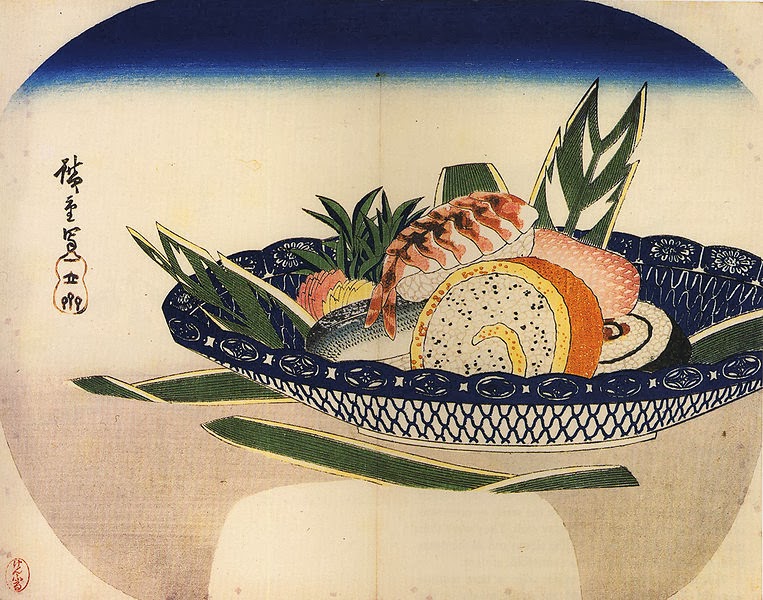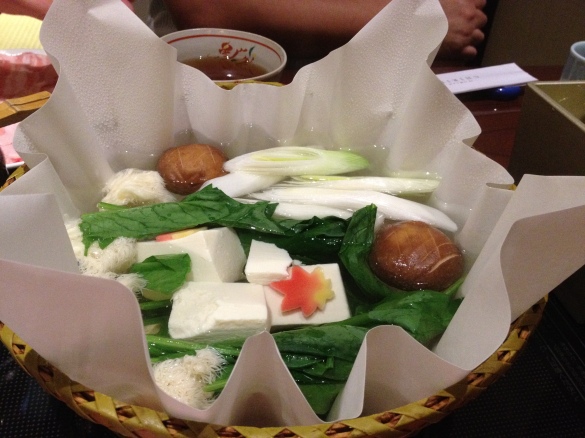 The Japanese sure love the Chinese-style spicy noodles known as tantanmen (or dandan mian in Mandarin Chinese). Previously, I wrote about two tantanmen joints in Tokyo, Rashohan in Kanda and Kisurin in Akasaka. Yesterday, I went to another well-regarded place called Yokarou (よかろう).
The Japanese sure love the Chinese-style spicy noodles known as tantanmen (or dandan mian in Mandarin Chinese). Previously, I wrote about two tantanmen joints in Tokyo, Rashohan in Kanda and Kisurin in Akasaka. Yesterday, I went to another well-regarded place called Yokarou (よかろう).
Tag Archives: Japanese cuisine
No Fish, No Life: Kaikaya By the Sea in Shibuya
There can’t be life without ramen, but sometimes you need other things too. And in Japan, the land of sushi, one of those things is seafood.
Recently, I celebrated a friend’s birthday at a cool, quirky restaurant called Kaikaya By the Sea (開花屋) in Shibuya. Located about a 10-15 minute walk from Shibuya Crossing, Kaikaya has an eclectic menu of seafood dishes inspired by cuisine from around the world. You’ll see a lot of the places that likely inspired owner-chef Teruyuki Tange in the travel photos posted in the restroom and other parts of the restaurant.
A Brief History of Japanese Food
 The global popularity of Japanese food has never been greater, as underscored by the recent decision of the United Nations’ cultural agency, UNESCO, to add traditional Japanese cuisine to its “intangible world heritage” list. It’s easy to think that the Japanese cuisine we know and enjoy today has an ancient, dynamic, and delicious history and that Japan has always been a nation of foodies.
The global popularity of Japanese food has never been greater, as underscored by the recent decision of the United Nations’ cultural agency, UNESCO, to add traditional Japanese cuisine to its “intangible world heritage” list. It’s easy to think that the Japanese cuisine we know and enjoy today has an ancient, dynamic, and delicious history and that Japan has always been a nation of foodies.
In reality, for much of Japan’s history, Japanese food wasn’t that good (unremarkable if not downright awful, in fact) and there wasn’t much of it to go around. That’s one of the central insights of “Slurp: A Social and Culinary History of Ramen – Japan’s Favorite Noodle Soup” by historian Barak Kushner of the University of Cambridge. While Japan’s iconic noodle dish is certainly the centerpiece of this book (it begins with a recounting of Kushner’s first trip to an Ichiran ramen shop), “Slurp” is a broader exploration of the history and dramatic evolution of Japanese cuisine and food culture into the phenomenon that we see today.
Warayakiya: Into the Fire
A few weeks ago, Tokyo was hit with its worst snowstorm in about 20 years. Depending on how you look at it, it was either a bad time to go out for dinner or a perfect time, given that I went to a cozy izakaya called Warayakiya (わらやき屋) located on a side street just off of Roppongi Crossing. But given the high marks it has gotten from several of my friends and professional reviewers on the internet, I figured that it would be worth the adventure through the wind and snow.
Craft Beer, Pork Belly, and Meat Pies
Last week, I took another trip to 246 Common in Omotesando, where I had a gorgeous bowl of Okinawan stewed pork belly (rafute) served over rice. There were two pieces of pork — the meat on one piece was well-marbled with fat, while the other looked like a tea sandwich featuring a couple of layers of meat sandwiched between fat. A lot of folks will probably be turned off by the fattiness, but if you don’t have a problem with it, you’ll be richly rewarded with some amazing tasting pork. Two thumbs up!
Michelin Guide Japan 2014

Many of you will probably be interested to know that Michelin has released its 2014 guide to restaurants in Japan, including the Tokyo-Yokohama-Shonan area. It’s available online, so there’s no need to run out and get a hard copy version.
Michelin rated restaurants are not the primary focus of this blog (though I would not turn down the chance to go to and write about one), but I would point out that some of the restaurants can be relatively affordable for lunch. For example, the second place shown on the alphabetized list of Tokyo restaurants is a place called Akasaka Tan-tei, a one star which serves Okinawan cuisine in the Akasaka neighborhood. Lunch sets run from 1,800-8,000 yen, while dinner costs between 10,500-15,750 yen.
Hope you enjoy perusing the guide!
Oneshiki Jun At Tokyo Ramen Street
I’ve noticed that a lot of folks who check out this blog are interested in Tokyo Ramen Street at Tokyo Station, so I thought I should highlight another of its shops — Oneshiki Jun (俺式 純). Oneshiki, which is part of a chain of ramen restaurants called Setagaya, is one of the new ramen joints that moved in following recent renovations to the Street. It specializes in tonkotsu (pork bone broth) ramen and offers a couple of tsukemen (dipping noodle) options as well.
Shabu Shabu: Do It Yourself Hotpot
 We’re deep into autumn here in Tokyo, which means it’s the ideal season for shabu shabu — Japanese-style do-it-yourself hotpot. One might think that there isn’t much variation to something as simple and straightforward as boiled meat and vegetables, but I recently learned that there are indeed some regional differences in shabu shabu.
We’re deep into autumn here in Tokyo, which means it’s the ideal season for shabu shabu — Japanese-style do-it-yourself hotpot. One might think that there isn’t much variation to something as simple and straightforward as boiled meat and vegetables, but I recently learned that there are indeed some regional differences in shabu shabu.
Yamaguchi: The Ultimate Chicken Ramen
Not too long ago, my friend BT (who introduced me to Ichiran Ramen) told me that I should try a ramen joint called Yamaguchi (やまぐち) near Waseda University, on the western side of the city. He said that it had been touted by a respected Japanese ramen expert as having “the ultimate chicken ramen,” and obviously I was intrigued. So a couple of days ago, I went down there with several friends to check it out. And wow, did my taste buds have a great day!
The Simple Delight of a Persimmon
 One of the autumnal foods that I’ve been enjoying the last few weeks in Japan is persimmon. Although they grow in the United States, persimmons are not what I would call a widely popular fruit with American consumers. I’ve only had them a couple times back in America, and in both instances they were mushy and overripe. Needless to say, I didn’t like them.
One of the autumnal foods that I’ve been enjoying the last few weeks in Japan is persimmon. Although they grow in the United States, persimmons are not what I would call a widely popular fruit with American consumers. I’ve only had them a couple times back in America, and in both instances they were mushy and overripe. Needless to say, I didn’t like them.
My experience with persimmons in Japan, specifically with the tomato-shaped Fuyu variety, are another story. They are simply wonderful, assuming you eat them when they are ripe (otherwise, they are bitter and rock hard). The flesh is firm and crisp, with a great honey-like taste. No wonder the scientific name for persimmons, Diospyros, is ancient Greek for “fruit of the Gods.” And I’ve seen them grow in many backyards in suburban and rural Japan.
When looking for a ripe persimmon, choose one with smooth and transparent skin, and a good overall orange color. You can also let it ripen on a counter or in a paper bag until it reaches a bright coloring. When it ready, cut the persimmon like you would a tomato, slicing off the top where the leaves are. I prefer to eat persimmons with the skin on, but you can peel them as well.
It’s a reminder that great, seasonal food in Japan doesn’t always require going to an eatery or a lot of time spent in the kitchen. Sometimes, it’s just a matter of going down to the local grocery store and picking up a simple persimmon.





